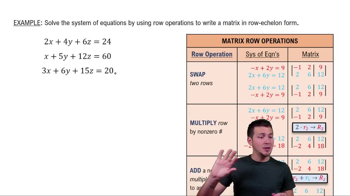Table of contents
- 0. Review of Algebra4h 16m
- 1. Equations & Inequalities3h 18m
- 2. Graphs of Equations43m
- 3. Functions2h 17m
- 4. Polynomial Functions1h 44m
- 5. Rational Functions1h 23m
- 6. Exponential & Logarithmic Functions2h 28m
- 7. Systems of Equations & Matrices4h 6m
- 8. Conic Sections2h 23m
- 9. Sequences, Series, & Induction1h 19m
- 10. Combinatorics & Probability1h 45m
7. Systems of Equations & Matrices
Introduction to Matrices
Problem 29a
Textbook Question
Use the Gauss-Jordan method to solve each system of equations. For systems in two variables with infinitely many solutions, write the solution with y arbitrary. For systems in three variables with infinitely many solutions, write the solution set with z arbitrary. See Examples 1-4. 3/8x - 1/2y = 7/8 -6x + 8y = -14
 Verified step by step guidance
Verified step by step guidance1
Step 1: Write the system of equations in matrix form. The given system is: \( \frac{3}{8}x - \frac{1}{2}y = \frac{7}{8} \) and \( -6x + 8y = -14 \). This can be written as an augmented matrix: \[ \begin{bmatrix} \frac{3}{8} & -\frac{1}{2} & | & \frac{7}{8} \\ -6 & 8 & | & -14 \end{bmatrix} \]
Step 2: Perform row operations to get a leading 1 in the first row, first column. Multiply the first row by \( \frac{8}{3} \) to make the first element 1: \[ \begin{bmatrix} 1 & -\frac{4}{3} & | & \frac{14}{3} \\ -6 & 8 & | & -14 \end{bmatrix} \]
Step 3: Eliminate the first column of the second row by adding 6 times the first row to the second row: \[ \begin{bmatrix} 1 & -\frac{4}{3} & | & \frac{14}{3} \\ 0 & 0 & | & 0 \end{bmatrix} \]
Step 4: Interpret the resulting matrix. The second row \( 0 = 0 \) indicates that the system has infinitely many solutions. The first row represents the equation \( x - \frac{4}{3}y = \frac{14}{3} \).
Step 5: Express the solution in terms of \( y \). Solve for \( x \) in terms of \( y \): \( x = \frac{14}{3} + \frac{4}{3}y \). The solution set is \( \{ (x, y) \mid x = \frac{14}{3} + \frac{4}{3}y, y \text{ is arbitrary} \} \).
Recommended similar problem, with video answer:
 Verified Solution
Verified SolutionThis video solution was recommended by our tutors as helpful for the problem above
Video duration:
6mPlay a video:
Was this helpful?
Key Concepts
Here are the essential concepts you must grasp in order to answer the question correctly.
Gauss-Jordan Elimination
The Gauss-Jordan elimination method is a systematic procedure used to solve systems of linear equations. It involves transforming the system's augmented matrix into reduced row echelon form, allowing for easy identification of solutions. This method can handle both unique solutions and cases with infinitely many solutions by manipulating the rows of the matrix through row operations.
Recommended video:
Guided course

Solving Systems of Equations - Elimination
Infinitely Many Solutions
A system of equations has infinitely many solutions when at least one equation can be derived from another, leading to dependent equations. In such cases, the solution can be expressed in terms of one or more free variables, allowing for a range of values. For example, in a two-variable system, if y is free, the solution can be written as x in terms of y, indicating that y can take any value.
Recommended video:

Categorizing Linear Equations
Augmented Matrix
An augmented matrix is a matrix that represents a system of linear equations, including the coefficients of the variables and the constants from the equations. It is formed by appending the constant terms as an additional column to the coefficient matrix. This format is essential for applying the Gauss-Jordan elimination method, as it simplifies the process of finding solutions to the system.
Recommended video:
Guided course

Introduction to Matrices

 4:35m
4:35mWatch next
Master Introduction to Matrices with a bite sized video explanation from Patrick Ford
Start learningRelated Videos
Related Practice










